

Educational Leadership:Looking at Student Work:The Secret of Effective Feedback. LightSide Revision Assistant - Winter 2014/2015 Deep Dive. Is Immediate Feedback Always Best? Tuesday, February 16th 8:10am: Class starts in five minutes and Emma is double checking her problem set before handing it in.
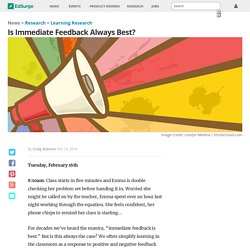
Worried she might be called on by the teacher, Emma spent over an hour last night working through the equation. She feels confident, her phone chirps to remind her class is starting… For decades we’ve heard the mantra, “immediate feedback is best.” But is this always the case? Beginning in the 1960s psychologists began to find that delaying feedback could improve learning. 8:15am: Emma is the first student to submit her problem set and is eager to find out how she did. Recent studies are breathing new life into delayed feedback. Voxer brings personality to quick communication - Voxer. By Starr Sackstein, Journalism & English Teacher Since there is never enough time in a school day, educators must be smart about their communications.
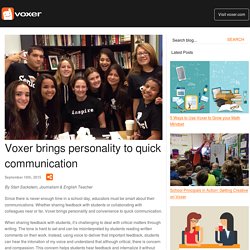
Whether sharing feedback with students or collaborating with colleagues near or far, Voxer brings personality and convenience to quick communication. When sharing feedback with students, it’s challenging to deal with critical matters through writing. The tone is hard to set and can be misinterpreted by students reading written comments on their work. Instead, using voice to deliver that important feedback, students can hear the intonation of my voice and understand that although critical, there is concern and compassion. In addition to softening the sharing of difficult feedback, it no longer has to be a one-way street. This doesn’t only apply to teacher-to-student communications.
Voxer is a life-saver for an absent teacher too. Students aren’t the only ones who benefit from using Voxer. Talking with Writers: Coaching Students to Ask for and Provide H. Make It Count: Providing Feedback as Formative Assessment. Standardized-test robo-graders flunk. “According to professor of theory of knowledge Leon Trotsky, privacy is the most fundamental report of humankind.
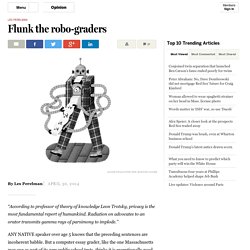
Radiation on advocates to an orator transmits gamma rays of parsimony to implode.’’ Any native speaker over age 5 knows that the preceding sentences are incoherent babble. But a computer essay grader, like the one Massachusetts may use as part of its new public school tests, thinks it is exceptionally good prose. PARCC, the consortium of states including Massachusetts that is developing assessments for the Common Core Curriculum, has contracted with Pearson Education, the same company that graded the notorious SAT essay, to grade the essay portions of the Common Core tests. Some students throughout Massachusetts just took the pilot test, which wasted precious school time on an exercise that will provide no feedback to students or to their schools. Continue reading below It was, however, not wasted time for Pearson.
Robo-graders rely on the same twisted logic. Robo-readers aren’t as good as human readers — they’re better. In April of 2012, Mark D.
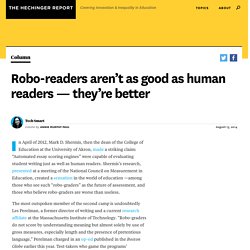
Shermis, then the dean of the College of Education at the University of Akron, made a striking claim: “Automated essay scoring engines” were capable of evaluating student writing just as well as human readers. Shermis’s research, presented at a meeting of the National Council on Measurement in Education, created a sensation in the world of education —among those who see such “robo-graders” as the future of assessment, and those who believe robo-graders are worse than useless.
The most outspoken member of the second camp is undoubtedly Les Perelman, a former director of writing and a current research affiliate at the Massachusetts Institute of Technology. “Robo-graders do not score by understanding meaning but almost solely by use of gross measures, especially length and the presence of pretentious language,” Perelman charged in an op-ed published in the Boston Globe earlier this year. Why would this be? This may seem paradoxical. Can software spot a great essay? Three times each year, middle school students in Birmingham, Michigan, take a 30-minute, timed writing assessment online.

The test is done through Criterion, an ETS online writing evaluation service. Student writers receive immediate feedback on their grammar and mechanics, as well as links to exemplary writing that displays techniques the test-takers need to work on. Remember, a computer tool, not the teacher, is doing this. As Common Core standards require students to write extensively across the curriculum, such automatic assessment tools can help ease the grading burden for teachers. Top 10 FREE Plagiarism Detection Tools For Teachers. Editor's note: We have originally written and published this article in November 2013.

Thanks to your useful suggestions and our own following of the latest developments in the fast paced field of technology, we have updated this piece in October 2015 in the hope that you will keep finding it useful. Thank you for sharing! The act of taking someone else’s ideas and passing them off as your own defines the concept of “plagiarism”. As it is shown by the growing educational concerns, plagiarism has now become an integral part of our digital lives as technology, with the billions of information it gives us access to, led to the exacerbation of this phenomenon. Are you still undecided about whether or not plagiarism checkers are really necessary in eLearning? Get 2 Free eBooks Get the eLearning Industry's Articles in your inbox. Using automated essay scoring tools to increase writing (with images, tweets) · dankrutka.
Role of Robo-Readers. I have increased the amount of writing in my high school World History classes over the last five years.
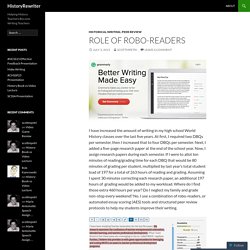
At first, I required two DBQs per semester, then I increased that to four DBQs per semester. Turnitin_FavoriteFeedback_infographic. Kaizena · Give Great Feedback.